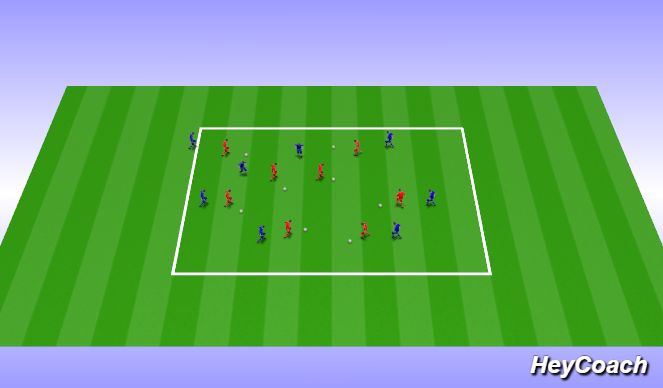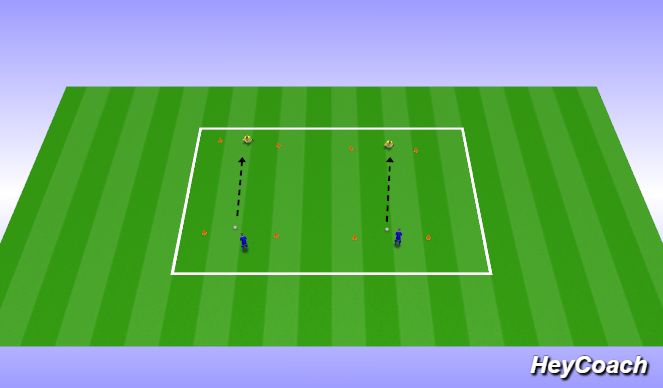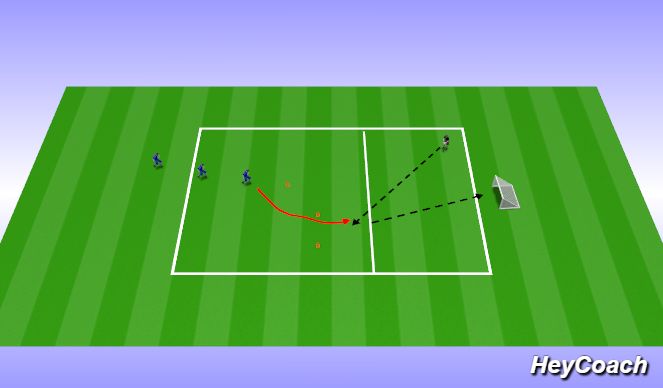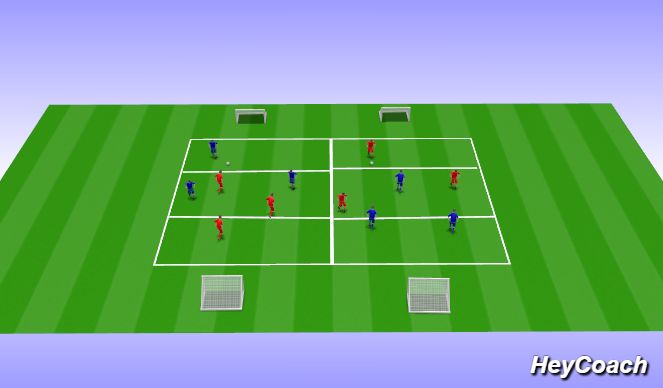
Objective:
A fun warm-up that teaches dribbling, change of pace and direction.
Also encourages disciplined marking.
Organization:
In pairs with a ball between two. If there is an odd number make one a trio or coach joins in.
On a signal the player with the ball (the Dribbler) tries to lose his/her Shadow.
Shadow must be disciplined and persistent. After a few seconds the coach shouts "Change!" and the Shadow becomes the Dribbler, and vice-versa. Don't go for too long (30 seconds) as the activity is very demanding. Introduce other pairs activities in between the runs, e.g., try to head the ball back and forth; play Keep-Up; play Nut Megs (ball is played through the legs of straddling partner).
Teaching:
Try to burst away from the Shadow by change of pace and direction.
Shadow tries to stay "touch tight."
Target:
To lose the Shadow; conversely not to lose the Dribbler.

Objective:
To create a fun, yet challenging environment.
To teach the correct way of diving on the side for goalkeeping.
Organization:
Set out as many goals (3-yards apart) as there are players (goalkeepers).
Two goalkeepers per area, one with a ball, both kneeling up facing one another four yards apart.
Important that the players kneel in an upright position and not sit back on their heels. Feet/toes should be on the imaginary goal line. Balls must be rolled along the ground to the side of each keeper, not straight, but not so far to the side that the receiver cannot roll over and collect the ball. After receiving the ball the keeper should roll back to the kneeling position.
Teaching:
Hands and arms should be pushed reach forward, palms towards ball, to stop ball in front of body.
Hands and arms should relax into a "crooked" position as the pace is taken off the ball.
Upper knee should be drawn in comfortably across the body as the ball is received.
Lower leg should remain loosely trailing. Head and upper shoulder should be drawn over and above the height of the ball. "W" hand position is employed, but with ball "trapped" by the upper hand on top of the ball and lower hand behind the ball and so use the ground as the so-called "Third Hand." (See graphic above)
Target:
To start with, everyone is practicing the side dive technique and there is no pressure.
Then the "battle" begins. The top field is designated the King's Court (coach decides the top and bottom). Ball must be rolled, not thrown. Goals only count if they are "clean" (must not touch the cone). Service must be from a position where the attacker has his/her feet touching the goal line.
Each "round" goes for 2- to 3-minutes and a winner is declared (coach needs a tie breaking method - "paper, scissors, stone") and the changes are made as follows: The winner in the King's Court retains the #1 position. The loser goes all the way to the bottom court. The other winners move up one place. The battle recommences. With large groups have two or three King's Courts with 3 or 4 fields per sub-group. Keep it fun and therefore downplay the "winning at all costs" attitude.

Objective:
To develop accurate passing and shooting with both feet.
To gain a simple understanding of corner kicks
Organization:
Place balls in one corner of playing area. Coach rolls ball by foot or by hand.
Coach shouts "Go!" and player at first cone must go around second cone.
Shooting player goes behind goal to retrieve the shot, and then returns to end of line.
No goalkeeper, so players are encouraged to kick accurately to succeed.
Change players and cones to opposite side. Progression (this is more difficult, so let them master the simpler practice first): players take corner kick themselves; employ a simple rotation of players.
Teaching:
As players become better, narrow the goal or deliver quicker passes.
Point out that most shots in illustration will be taken with the left foot (most will be predominantly right-footed). Bias the service to encourage left (or right footed) shots. Total concentration: head down, eyes on the ball. Encourage accuracy rather than power shooting. Use inside of foot - like a hockey stick.
Encourage players to strive to become "two-footed."
Target:
To record the number of the team's scoring attempts that succeed in 20 shots, and keep score at each practice as an incentive to improve.

Objective:
To create a Jamboree atmosphere.
Children just play without any coaching
Organization:
Any number of players above 11 can create a Jamboree atmosphere. Consider joining up with another team who practice at the same time. If less than 12 players, make up three teams (of 3 or 4 players). Have a second activity area (such as the Circle Game) as one team waits their turn to play.
With 12 or more put in two fields or more, depending on numbers. With more than one field synchronize the play. The time-keeper starts the game for everyone with a long whistle, and signals the end of the quarters and the end of the games. One long blast signals the start of play.
A short blast signals the end of each quarter.
After the end of each quarter the substitutions/rotations take place and the game is recommenced as quickly as possible without a signal from the time-keeper.
Restart with an indirect free kick from the part of the field where the period ended with the kick taken by the team that was in possession.
A short blast, followed by a long blast signifies the end of the game at the conclusion of the fourth quarter.
Play 4-periods of two minutes. Try not to have more than 4 players on a team.
With 4, at the end of each period, the sub becomes the goalkeeper, the goalkeeper moves out onto the field. One field player comes off. After 4-periods each player will have played 3 quarters - once in goal and twice on the field. Use the same principle with 3 players or 5 players (equal time in goal and on the field). Teams work on a Round-Robin format.
Teaching:
Coaches have to work hard to say … nothing!
Target:
To enjoy the sheer fun of unadulterated soccer with plenty of opportunities to get touches of the ball and score goals.